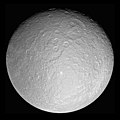Attēls:PIA07763 Rhea full globe5.jpg

Šī priekšskata izmērs: 600 × 600 pikseļi. Citi izmēri: 240 × 240 pikseļi | 480 × 480 pikseļi | 768 × 768 pikseļi | 1 024 × 1 024 pikseļi | 2 048 × 2 048 pikseļi | 4 920 × 4 920 pikseļi.
Sākotnējais fails (4 920 × 4 920 pikseļi, faila izmērs: 2,67 MB, MIME tips: image/jpeg)
Faila hronoloģija
Uzklikšķini uz datums/laiks kolonnā esošās saites, lai apskatītos, kā šis fails izskatījās tad.
| Datums/Laiks | Attēls | Izmēri | Dalībnieks | Komentārs | |
|---|---|---|---|---|---|
| tagadējais | 2018. gada 27. augusts, plkst. 10.15 |  | 4 920 × 4 920 (2,67 MB) | PlanetUser | Reverted to version as of 08:13, 13 March 2015 (UTC) |
| 2018. gada 15. augusts, plkst. 13.09 |  | 4 920 × 4 920 (2,66 MB) | The NMI User | Reverted to version as of 23:49, 14 August 2018 (UTC) | |
| 2018. gada 15. augusts, plkst. 02.59 |  | 4 920 × 4 920 (2,64 MB) | The NMI User | rv, fixed | |
| 2018. gada 15. augusts, plkst. 02.49 |  | 4 920 × 4 920 (2,66 MB) | The NMI User | Try making black | |
| 2018. gada 15. augusts, plkst. 02.44 |  | 4 920 × 4 920 (2,65 MB) | The NMI User | Fixed | |
| 2018. gada 13. augusts, plkst. 11.09 |  | 4 920 × 4 920 (3,67 MB) | The NMI User | Removing black borders | |
| 2018. gada 13. augusts, plkst. 11.01 |  | 4 920 × 4 920 (2,67 MB) | The NMI User | Reverted to version as of 08:13, 13 March 2015 (UTC) | |
| 2018. gada 13. augusts, plkst. 10.56 |  | 4 920 × 4 920 (5,67 MB) | The NMI User | Black background | |
| 2015. gada 13. marts, plkst. 11.13 |  | 4 920 × 4 920 (2,67 MB) | MoreTomorrow | making square (to match other planet/moon images) | |
| 2008. gada 30. oktobris, plkst. 09.43 |  | 4 920 × 4 820 (2,68 MB) | WolfmanSF | This is the same full-resolution NASA image, with black panels added to the margins and some Photoshop processing to enhance contrast. |
Faila lietojums
Šo failu izmanto šajās 2 lapās:
Globālais faila lietojums
Šīs Vikipēdijas izmanto šo failu:
- Izmantojums af.wikipedia.org
- Izmantojums ar.wikipedia.org
- قالب:المجموعة الشمسية
- قائمة أجرام المجموعة الشمسية مرتبة حسب الحجم
- قائمة أجرام النظام الشمسي المستديرة بالجاذبية
- قائمة الأقمار الطبيعية
- خط زمني لاكتشاف كواكب المجموعة الشمسية وأقمارها
- اكتشاف واستكشاف النظام الشمسي
- قائمة أنواع الكواكب
- بوابة:زحل/مقالة مختارة وصورة لأحد أقمار زحل
- قائمة أكبر الفوهات في المجموعة الشمسية
- 1981 ميداس
- Izmantojums ary.wikipedia.org
- Izmantojums arz.wikipedia.org
- Izmantojums ast.wikipedia.org
- Izmantojums as.wikipedia.org
- Izmantojums azb.wikipedia.org
- Izmantojums be.wikipedia.org
- Izmantojums bh.wikipedia.org
- Izmantojums ca.wikipedia.org
- Izmantojums ckb.wikipedia.org
- Izmantojums de.wikipedia.org
- Izmantojums el.wikipedia.org
- Izmantojums en.wikipedia.org
- Pioneer 11
- Rhea (moon)
- Cassini–Huygens
- Timeline of discovery of Solar System planets and their moons
- List of geological features on Rhea
- Naming of moons
- List of natural satellites
- List of gravitationally rounded objects of the Solar System
- Wikipedia:WikiProject Astronomy/Recognized content
- Portal:Solar System/Selected picture
- User:Dabomb87/Sandbox
- Tirawa (crater)
- Rings of Rhea
Skatīt šī faila pilno globālo izmantojumu.



